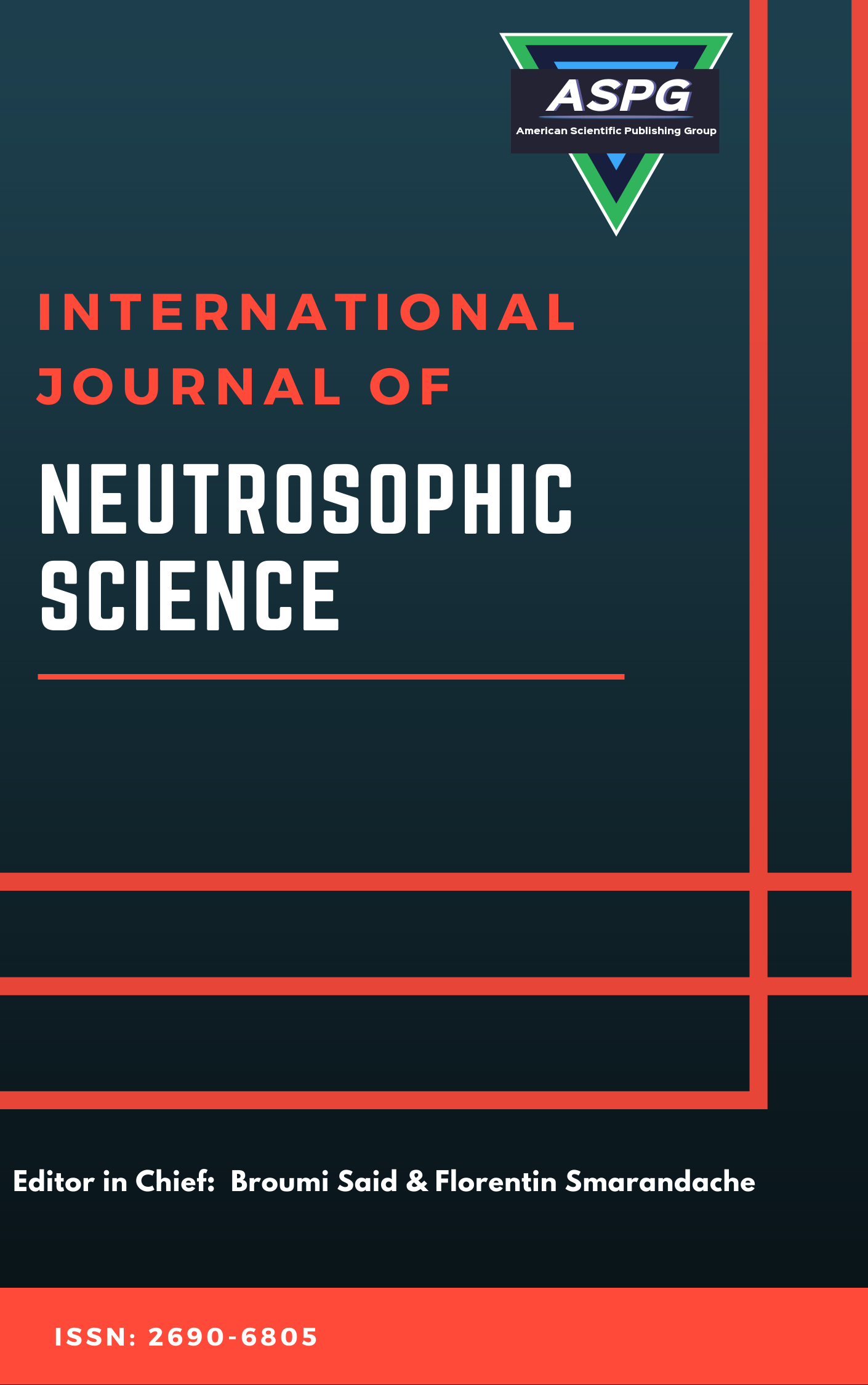

Volume 26 , Issue 3 , PP: 400-413, 2025 | Cite this article as | XML | Html | PDF | Full Length Article
Carmen Marina Méndez Cabrita 1 * , Josía Jeseff Isea Argüelles 2 , Luis Andrés Crespo Berti 3 , María Elena Infante Miranda 4
Doi: https://doi.org/10.54216/IJNS.260330
This project aims to concretize Ronald Dworkin's theory of legal integrity via Plithogenic n-SuperHyperGraphs. Therefore it investigates how such mathematical entities metaphorically and multidimensionally formulate moral coherence in legal interpretation. Using a mixed-method approach, this work will assess documents through a documentary assessment of Dworkin's written works (Law’s Empire and Taking Rights Seriously) to formulate a Plithogenic n-SuperHyperGraph of a case study featuring n-dimensional nodes as moral principles, moral assertions, and past decisions with hyperedges symbolizing the relationship between them generated by degrees of truth, falsity, or indeterminacy. Tools of graph visualization and neutrosophic computing will provide the legal assessment of characterization for coherence. The results will discuss whether the model intentionally visualizes the connections among the principles and how it assessed which characterizations would make the law most morally coherent under Dworkin's theory while acknowledging the indeterminacy in certain complicated cases. Thus, this study seeks to find correlations between which nodes function as the primary principles consistent with Dworkin's metaphor of the law's "chain." Ultimately, this research intends to present Plithogenic n-SuperHyperGraphs as a viable application to formally express Dworkin's theory for the sake of more moral legal determinations applicable to legal education or judicial assistive software, although generalizability will require cross-jurisdicDworkin; Legal Integrity; N- Superhypergraphs; Moral Coherence; Judicial Interpretation; Neutrosophic; Plithogenictional applications of the model.
Dworkin , Legal Integrity , N- Superhypergraphs , Moral Coherence , Judicial Interpretation , Neutrosophic , Plithogenic
[1] R. Dworkin, Law’s Empire. Cambridge, MA, USA: Harvard University Press, 1986, doi: 10.2307/j.ctvjghwvp.
[2] R. Alexy, A Theory of Constitutional Rights. Oxford, UK: Oxford University Press, 2002, doi: 10.1093/acprof:oso/9780198258216.001.0001.
[3] H. L. A. Hart, The Concept of Law, 2nd ed. Oxford, UK: Oxford University Press, 1994, doi: 10.1093/he/9780198761235.001.0001.
[4] J. Waldron, Law and Disagreement. Oxford, UK: Oxford University Press, 2006, doi: 10.1093/acprof:oso/9780199240876.001.0001.
[5] Sen, The Idea of Justice. Cambridge, MA, USA: Harvard University Press, 2009, doi: 10.4159/9780674054578.
[6] Rodríguez-Garavito, “Beyond the courtroom: The impact of judicial activism on socioeconomic rights in Latin America,” Texas Law Review, vol. 89, no. 7, pp. 1669–1698, 2011, doi: 10.2139/ssrn.1800677.
[7] J. Habermas, Between Facts and Norms: Contributions to a Discourse Theory of Law and Democracy. Cambridge, MA, USA: MIT Press, 1996, doi: 10.7551/mitpress/1564.001.0001.
[8] S. Himma, Conceptual Jurisprudence: Methodological Issues, Classical Questions. Cham, Switzerland: Springer, 2020, doi: 10.1007/978-3-030-31271-8.
[9] M. Dyzenhaus, The Long Arc of Legality: Hobbes, Kelsen, Hart. Cambridge, UK: Cambridge University Press, 2021, doi: 10.1017/9781108907507.
[10] R. Gargarella, The Law as a Conversation among Equals. Cambridge, UK: Cambridge University Press, 2022, doi: 10.1017/9781108865722.
[11] M. El-Bassiouny and M. A. Hossain, “Neutrosophic logic for decision-making in smart cities,” Sustainability, vol. 13, no. 4, p. 2155, 2021, doi: 10.3390/su13042155.
[12] Tamanaha, Legal Pluralism Explained: History, Theory, Consequences. Oxford, UK: Oxford University Press, 2021, doi: 10.1093/oso/9780190861551.001.0001.
[13] Stone Sweet, Proportionality Balancing and Constitutional Governance. Oxford, UK: Oxford University Press, 2023, doi: 10.1093/oso/9780198841395.001.0001.
[14] Sunstein, Law and Leviathan: Redeeming the Administrative State. Cambridge, MA, USA: Harvard University Press, 2020, doi: 10.2307/j.ctv1168qmg.
[15] M. A. Hossain, A. M. El-Bassiouny, and F. Smarandache, “Neutrosophic set theory and its applications in decision-making,” Mathematics, vol. 9, no. 18, p. 2262, 2021, doi: 10.3390/math9182262.
[16] H. J. Kim, “Neutrosophic decision-making for environmental management,” Environmental Science and Pollution Research, vol. 29, no. 15, pp. 44065–44076, 2022, doi: 10.1007/s11356-022-17781-8.
[17] R. C. M. A. de Almeida and I. C. B. de Lima, “A neutrosophic approach to evaluate the performance of renewable energy sources,” Renewable Energy, vol. 164, pp. 1010–1020, 2021, doi: 10.1016/j.renene.2020.09.054.
[18] S. K. Sharma, A. K. Gupta, and R. Kumar, “Neutrosophic logic-based decision-making for supply chain management,” Mathematical Problems in Engineering, vol. 2021, Article ID 8821543, 2021, doi: 10.1155/2021/8821543.
[19] X. Yang, K. Hayat, M. S. Raja, N. Yaqoob, and C. Jana, “Soft aggregation and interaction operators in an interval-valued q-rung orthopair fuzzy soft environment and their application to automation company evaluation,” IEEE Access, vol. 10, pp. 91424–91444, 2022, doi: 10.1109/ACCESS.2022.3206787.
[20] F. Smarandache, Neutrosophic Set in Decision Making and Optimization. Albuquerque, NM, USA: Infinite Study, 2020, doi: 10.13140/RG.2.2.13237.45287.
[21] F. Smarandache, “Introduction to super-hyper-algebra and neutrosophic super-hyper-algebra,” Latin American Association of Neutrosophic Sciences Journal, vol. 20, pp. 1–6, 2022.
[22] F. Smarandache, “Foundation of superhyperstructure and neutrosophic superhyperstructure,” Neutrosophic Sets and Systems, vol. 63, pp. 367–381, 2024.
[23] F. Smarandache, “Super hyper function and super hyper structure and their corresponding neutrosophic super hyper function and neutrosophic super hyper structure,” Latin American Association of Neutrosophic Sciences Journal, vol. 31, pp. 353–359, 2024.
[24] M. Rahmati and M. Hamidi, “On strong super hyper EQ algebras: A proof-of-principle study,” Plithogenic Logic and Computation, vol. 2, pp. 29–36, 2024.
[25] S. Jahanpanah and R. Daneshpayeh, “An outspread on valued logic superhyperalgebras,” Facta Universitatis, Series: Mathematics and Informatics, pp. 427–437, 2024.
[26] H. E. Khalid, G. D. Güngör, and M. A. N. Zainal, “Neutrosophic superhyperbitopological spaces: Additional topics,” Neutrosophic Optimization and Intelligent Systems, vol. 2, pp. 43–55, 2024.
[27] M. Ghods, Z. Rostami, and F. Smarandache, “Introduction to neutrosophic restricted superhypergraphs and neutrosophic restricted superhypertrees and several of their properties,” Neutrosophic Sets and Systems, vol. 50, pp. 480–487, 2022.
[28] F. Üçkardeş, “Use of a hierarchical loglinear model in multidirectional frequency tables and an application in suicide cases,” Sakarya University Journal of Computer and Information Sciences, vol. 5, pp. 269–277, 2022.
[29] N. Khalil, M. Elkholy, and M. Eassa, “A comparative analysis of machine learning models for predicting chronic kidney disease,” Sustainable Machine Intelligence Journal, vol. 5, no. 3, pp. 1–10, 2023.
[30] J. A. Carcillo et al., “Contingency table for assessing risk of mortality from systemic inflammation in severe sepsis cases,” Pediatric Critical Care Medicine, vol. 18, no. 2, pp. 143–150, 2017.